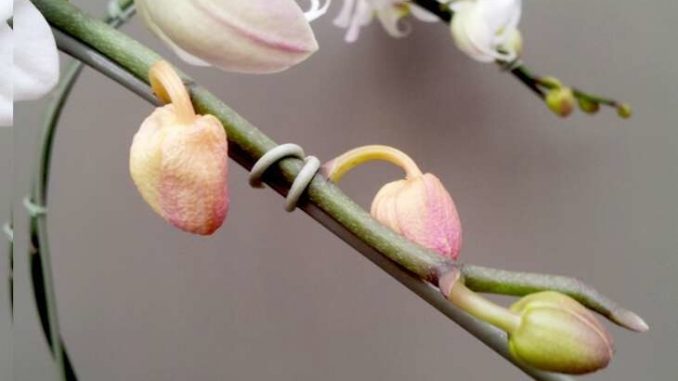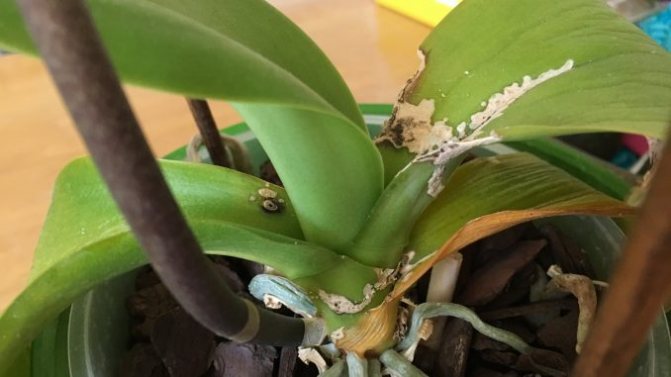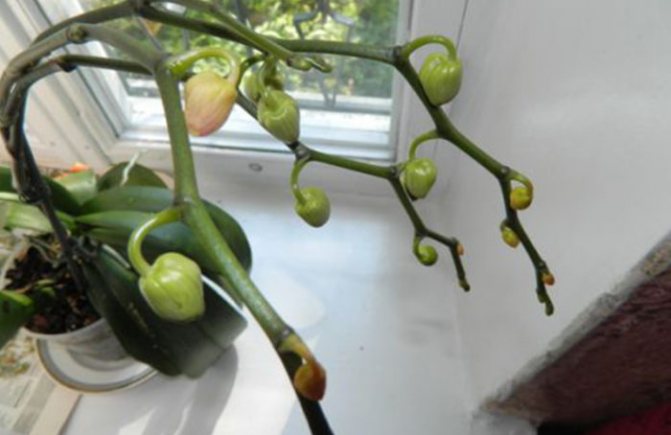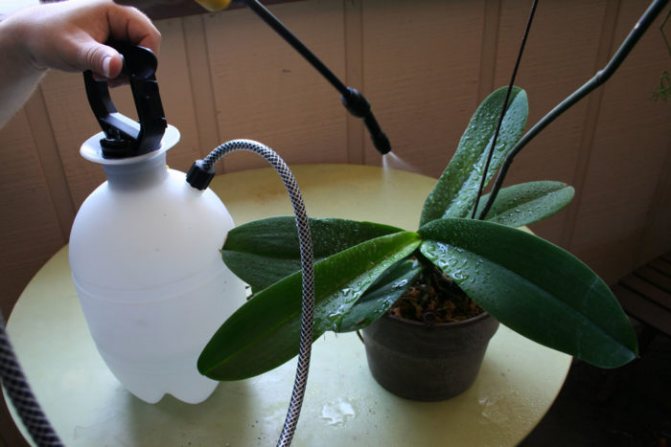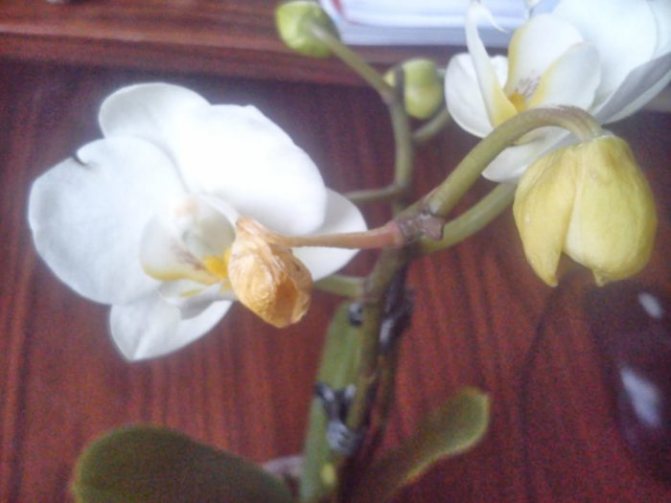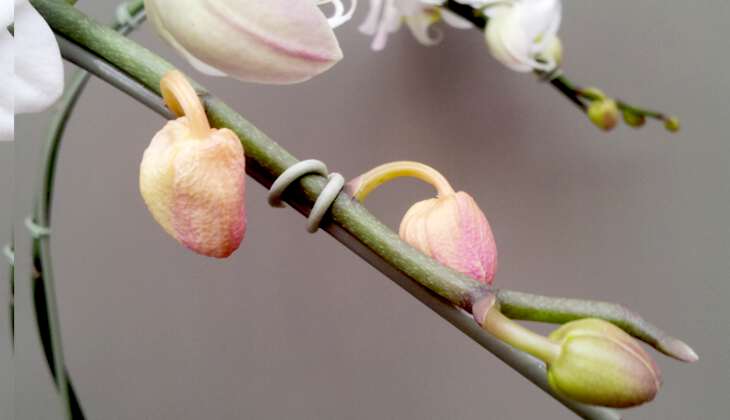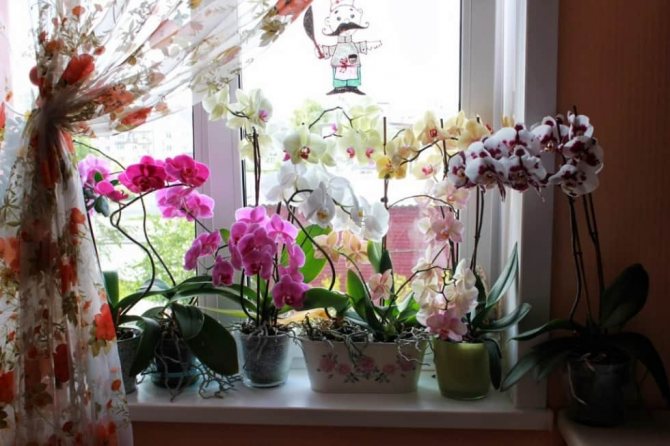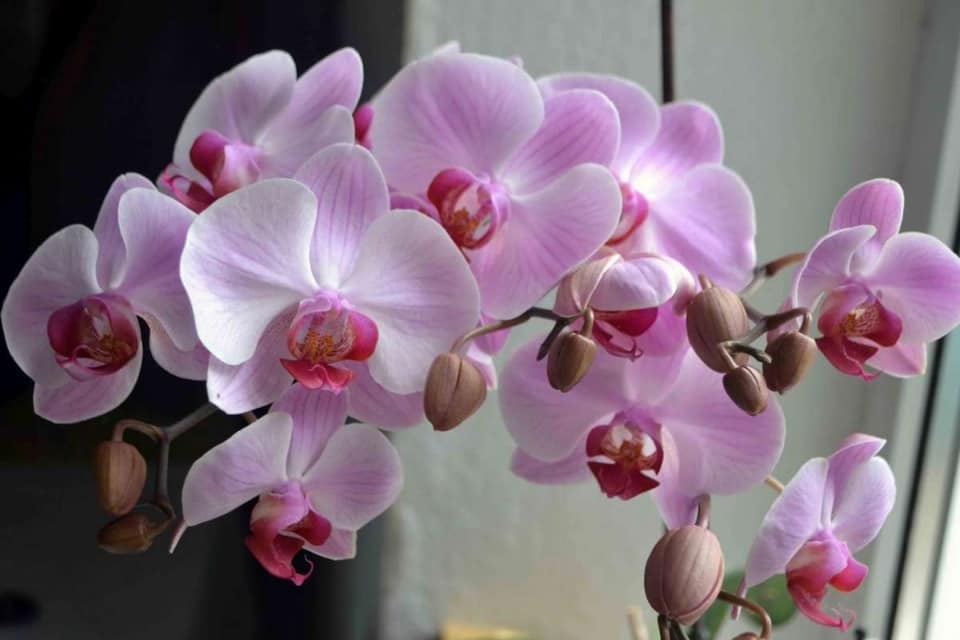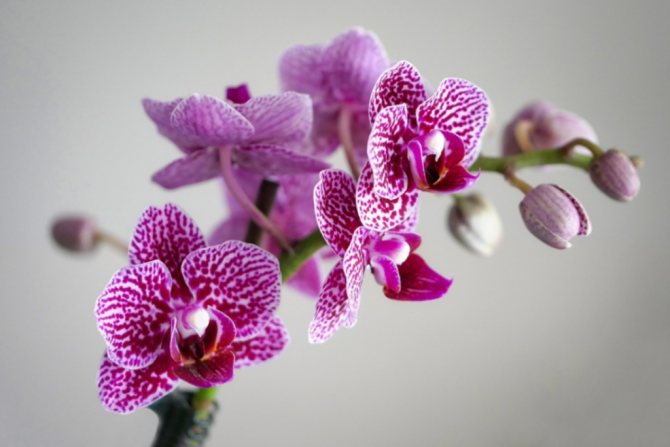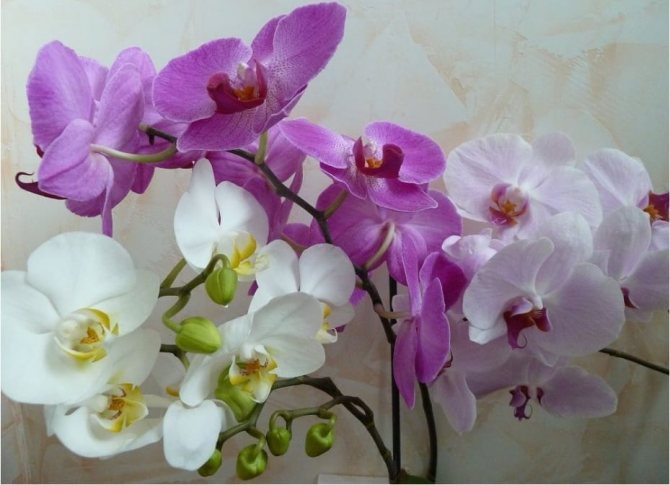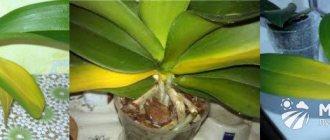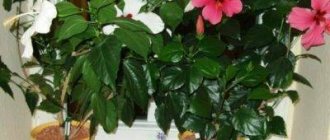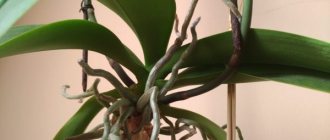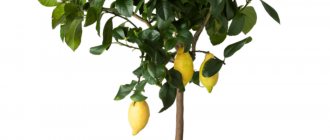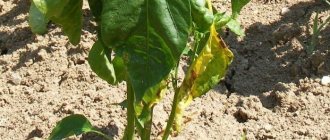Temperature conditions
With the slightest cooling of the orchid in the winter season, the bud may simply fall off, because the plant is used to growing in tropical forests, where the flowering period coincides with the summer season. Very high temperatures are also detrimental to the buds - burns can form and the plant will die. At temperatures above +27 degrees, the buds crumble. Try to insulate your batteries, because in winter, especially when the orchid is on the windowsill, the flower pot is heated from below with hot air, and cold air can blow from the window. This process is very detrimental to the buds and the plant as a whole. If you are transporting a flower, then insulate it before going outside (wrap it in several layers of newspaper).
Correct orchid bloom
Why do dracaena leaves fall - reasons
In order for an orchid to bloom luxuriantly and profusely, it needs to be provided with full and high-quality care:
- winter bloom must be maintained with backlighting. This should be done at least 3-4 hours in the evenings;
- in summer, flowering plants should be protected from direct sunlight. Instead of a window sill, the flower can be placed on a shelf near the window or placed on a table in the center of the room;
- to protect orchids from heating sources, it is worth raising the pots on the windowsill. To do this, use shelves or stands. You can also cover the battery with a damp towel;
- if the buds do not bloom due to low humidity, it is worth using a household humidifier. You can also systematically spray the room with warm water. You can place the flower near trays with damp expanded clay or pebbles. In this case, the roots of the plant should not touch the water;
- during the formation of the peduncle, the number of waterings should be reduced. When the flowers start to bloom, you can return to normal mode. This helps to avoid dehydration, especially in hot weather;
- it is recommended to feed the plant with fertilizers during the laying and development of the peduncle. During the blooming period, feeding is useless. This will not affect the size and number of buds in any way.
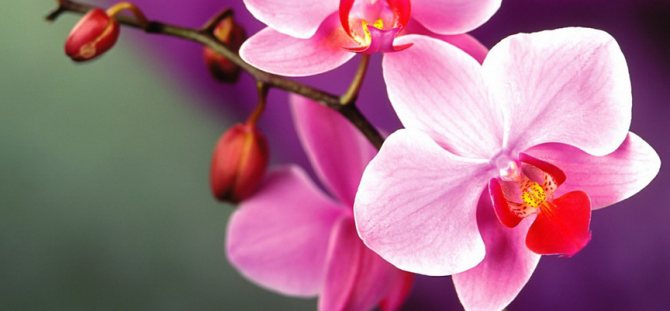
For a plant to bloom magnificently, it needs quality care.
The flowering of a culture depends on many external factors - moisture, temperature parameters, sun. In this case, plant care is also of great importance.
Age changes
The orchid is a long-liver, lives on average 60 years, but not in an apartment (there its life cycle reaches only 15-17 years). After the fifth year of life, the flowering process slows down, the orchid less often throws out a bud, which will bloom in the future. Such a bud often simply falls off, because the flower simply does not have enough strength to produce "offspring". In such cases, even fertilizers and vitamin cocktails will not be able to help.


Try to change the substrate on time (every 3 years), because it tends to decompose, releasing toxic substances that burn the orchid, starting from the roots and ending with the buds. If the buds and flowers fall from the bottom to the crown, then this is the reason for the aging of the flower, and if all at once, then look for the reason in another.
The main reasons for falling buds
Normally, the plant blooms for 3-4 months, then there is a break for 2-2.5 months, and then the buds appear again. However, sometimes they begin to wither and fall off immediately.In this case, the leaves may turn yellow and other problems appear. So why do unblown buds dry up in an orchid and what to do in such a situation?


Blooming orchid is a beautiful ornamental plant
Natural aging is believed to be one of the main causes of problems. In nature, an orchid can live for about 70 years. The plant is a long-liver. However, indoor flowers usually live no more than 7-15 years.
For your information! After 5 years, there is a risk that the orchid will no longer be able to bloom. At the same time, flower stalks appear, buds are formed, but they cannot bloom and almost immediately fall off. In such a situation, nothing can help the culture.
In other cases, it is necessary to change the care of the flower.
Improper watering
Lack or excess of moisture negatively affects the condition of the roots. They begin to dry out and rot. At the same time, the number of living roots becomes less and less, and the potential of the plant decreases.
Sooner or later, a moment comes when the remaining roots are not able to provide all the fragments of the culture with moisture. In such a situation, the culture can throw off flowers. Arrows often turn yellow and leaves wither.
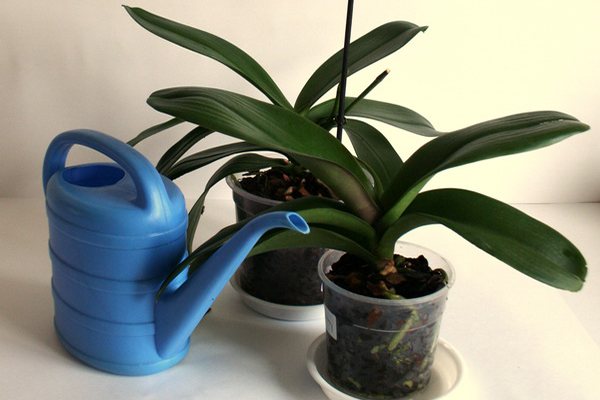

For full flowering, a culture needs high-quality watering.
Room temperature
If the orchid has picked up buds, but at the same time they do not bloom, the reason may be the wrong temperature regime in the room - an increase or decrease in indicators. Given the exotic origin, the culture requires quite high parameters.
Different varieties of orchids have their own temperature indicators, at which the plant experiences discomfort. So, phalaenopsis needs a temperature range of 14-40 ° C. With hypothermia or overheating of the culture, the most delicate parts of the plant - flowers and unopened buds - can fall off.
Overheating is heatstroke or sunburn. In winter, the plant can face the negative influence of heating sources. In summer, the culture can get burned due to exposure to direct sunlight. In this case, moisture evaporation is higher than its input. As a result, the bush dehydrates. In this case, the buds can dry out, which leads to their falling off.
Note! The bush can be overcooled due to ventilation, transportation, exposure to an air conditioner. In such a situation, the wilting of the peduncle and the development of root pathologies are observed. Sudden hypothermia often occurs after bathing, watering, spraying. In hot weather, the crop can be damaged by watering with too cold water.
Lack of lighting
In the autumn-winter period, the length of daylight hours is seriously reduced. At this time, the question becomes relevant: why do the flowers of an orchid fall and what to do in such a situation?
The answer is simple enough - to provide the plant with additional light sources. The duration of daylight hours should be at least 12 hours per day. At the same time, a plant with blossoming flowers does not suffer from a lack of light, but the buds in such a situation may not open.
In summer, it is important to remember that the direct rays of the sun can scorch delicate flowers.
Important! Sometimes the buds of an orchid fall due to the proximity to certain plants or fruits. Nuts, apples, tomatoes, bananas have a negative effect on the flower.
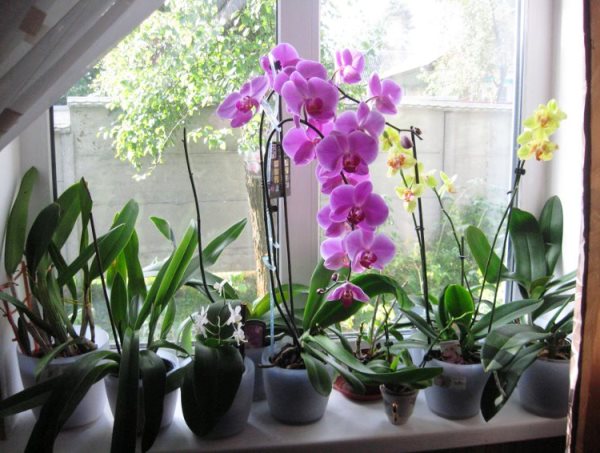

A culture needs a lot of light for a lush bloom.
How to help if the buds quickly crumbled without opening?
Falling buds occur most often when the plant is sick.
Orchid growers should know how to help with bud shedding. This is a very sad sight, and most likely, the reason is serious. After all, experienced people are unlikely to make mistakes in care during the budding period. Therefore, for amateurs it is advised to first check the conditions for keeping the exotic.The next stage is the definition of the disease and the methods of treatment:
- prepare a sterilized pruning tool;
- remove the plant from the pot;
- leave the roots in warm water for a couple of hours;
- carefully inspect and feel the entire root system;
- remove damaged areas with a pre-prepared tool;
- sprinkle the slices with an antiseptic that does not contain alcohol;
- if there are suspicions or visible symptoms of infectious diseases, treat the flower with a systemic fungicide;
- transplant the orchid into new soil and, if possible, into another pot;
- if everything is in order, the condition of the flower will not deteriorate, you can water it in a week;
- feed with a weakly concentrated solution of mineral fertilizers after 2 weeks.
Feeding rules during the budding period
Fertilizer plays an important role for all flowers that grow in pots.
There is no other way for them to get the necessary micro- and macroelements. for normal growth and development.
Without top dressing, indoor plants will not bloom, they need to just not enough strength.
Orchids also need help, they use special types of dressings, universal use is undesirable.
It is worth feeding the trunks during the period of active growthwhen the plant acquires new leaves and expels the peduncle.
Do it according to such rules:
- A plant in a pot is briefly soaked in water, this is done so that the absorption of nutrients is as efficient as possible;
- Then a fertilizing concentrate is added to the water, in such a solution the phalaenopsis is left for 15-20 minutes;
- After the expiration of the time, the pot is removed and excess water is allowed to drain.
After feeding, you should carefully monitor that there is no liquid in the pan or saucer, it can burn delicate roots phalaenopsis.
Her worth draining every timeas soon as it appears.
Orchids are fed once every two weeks with root dressings, in the intervals between them you can use foliar remedies.
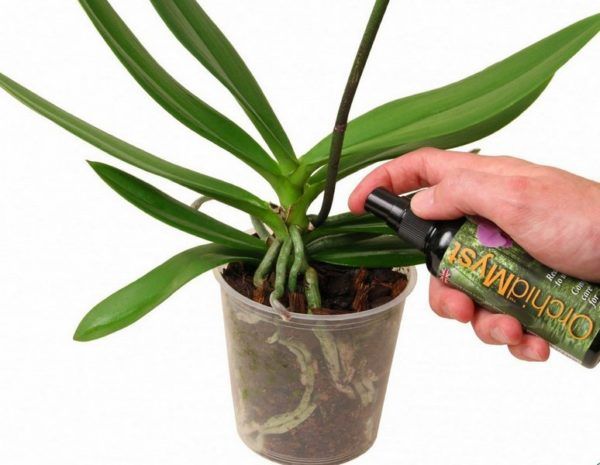

Observing all the recommendations for feeding the orchid, you will be able to watch its flowering for a long time.
Such bait specialists advise to alternate, you should not use both at the same time.
Diseases
The main reason for the drying of the buds is orchid disease. It is very unpleasant if the buds are not opened, their wilting is caused by orchid disease... The most favorable conditions for flowering have been created for the plant, but the flowers wither - the reason must be sought in this.
Also one of the signs of the disease various spots serve on flowers and buds. Sometimes these spots are very small, it is difficult to see them right away.
It could be:
- Fusarium in its various manifestations;
- Alternaria;
- A fungal or viral infection;
- Black spot (phyllostictosis).
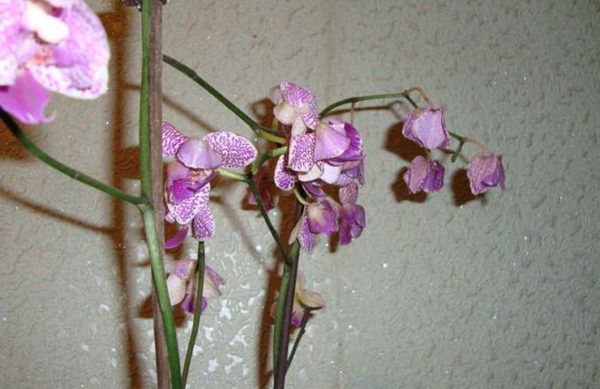

Withering of buds can occur due to various diseases.
Specifically determine what kind of infection attacked the orchid, possible only in laboratory conditions, since their external manifestations are quite similar. It will not be possible to save the flowering, but you can try to save the plant.
For this:
- Cut off the peduncle so that the orchid does not waste energy, and if the infection is observed only on the peduncle, it does not penetrate further. Treat the removal site with iodine or fucorcin;
- If the disease has already begun to manifest itself on the leaves, then cut off the affected areas to green tissue and treat with fucorcin;
- Isolate the diseased plant from the rest;
- Spray with a fungicide a couple of days after the wounds are healed, with a copper-based preparation;
- Water for 3 weeks with a broad-spectrum fungicide;
- In the summer and spring, be sure to transplant into a fresh substrate.
If the color of the flowers has changed, there are lighter stripes, you need to pay attention to young leaves and orchid pseudobulbs.The fact is that the virus on orchids manifests itself not only on flowers, its manifestation should also be on the leaves. In this case, the worst thing happened - it was a viral infection.
For health and normal flowering there must be a balance:
- Sunlight;
- Watering;
- Humidity;
- Temperature.
Attention! There is no cure for a viral infection, the plant must be disposed of.
How to revive a plant
Drying and shedding buds or flowers is a reaction to a stressful situation. In order to survive, culture eliminates all factors that require strength, including flowering.
If an old orchid cannot bloom, this is a natural phenomenon that does not harm it. When the reason for the falling off of the buds was a violation in the content, it is necessary to change the care.
Remove any dried stalks to help the plant recover. Correct irrigation and fertilization conditions, control air humidity and light level. Remove pungent crops and ethylene-emitting fruits to another location.
Assess the state of the peduncle: when it has retained its green color and elasticity, the dormant buds have a fresh and healthy appearance, there is a high probability of the appearance of flowers on the same arrow. If the top of the stalk is dry, cut it off, leaving a short dry area. It will take some time to recuperate, the plant needs rest. Most often, re-flowering is possible after about three months.


